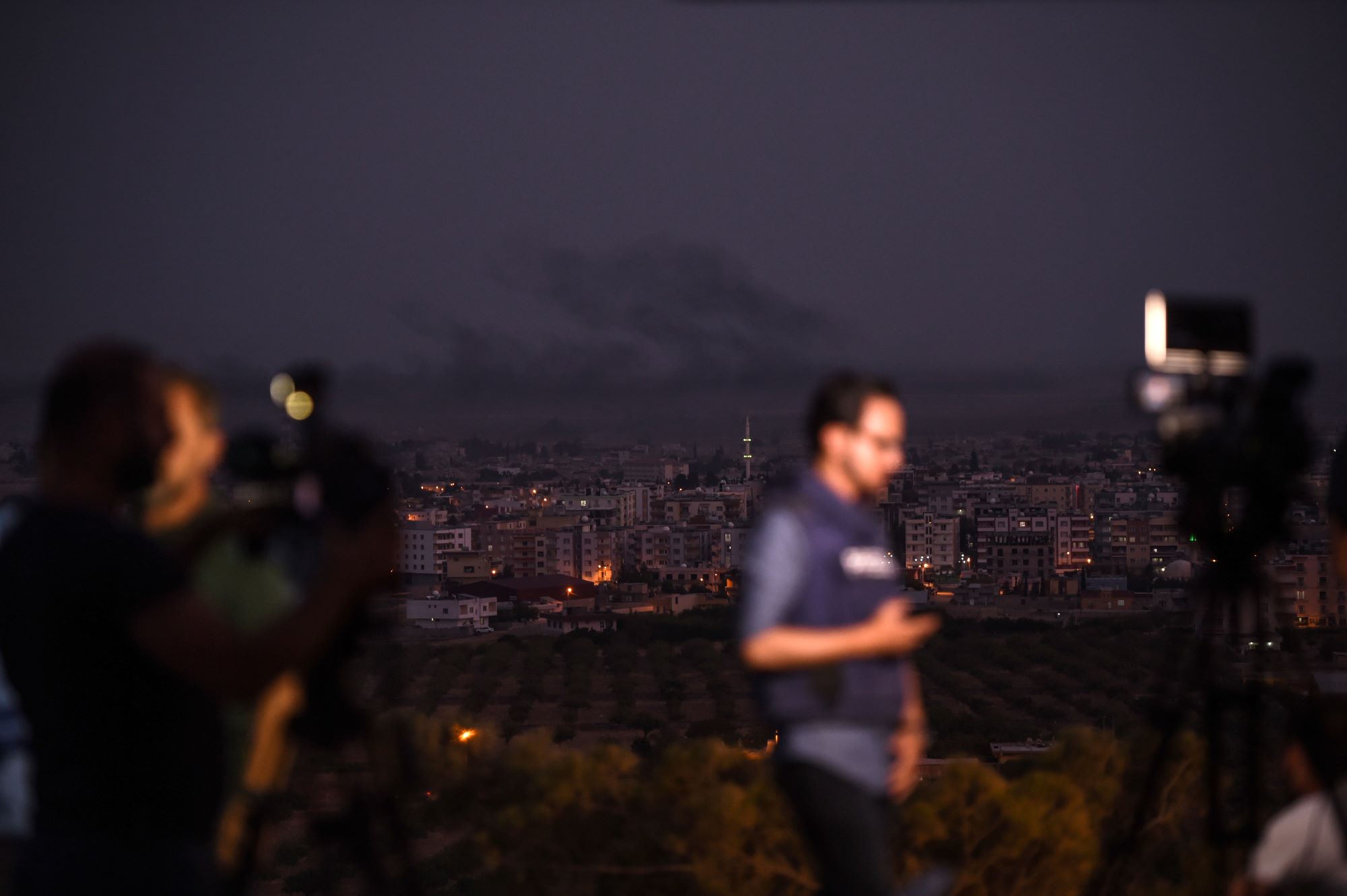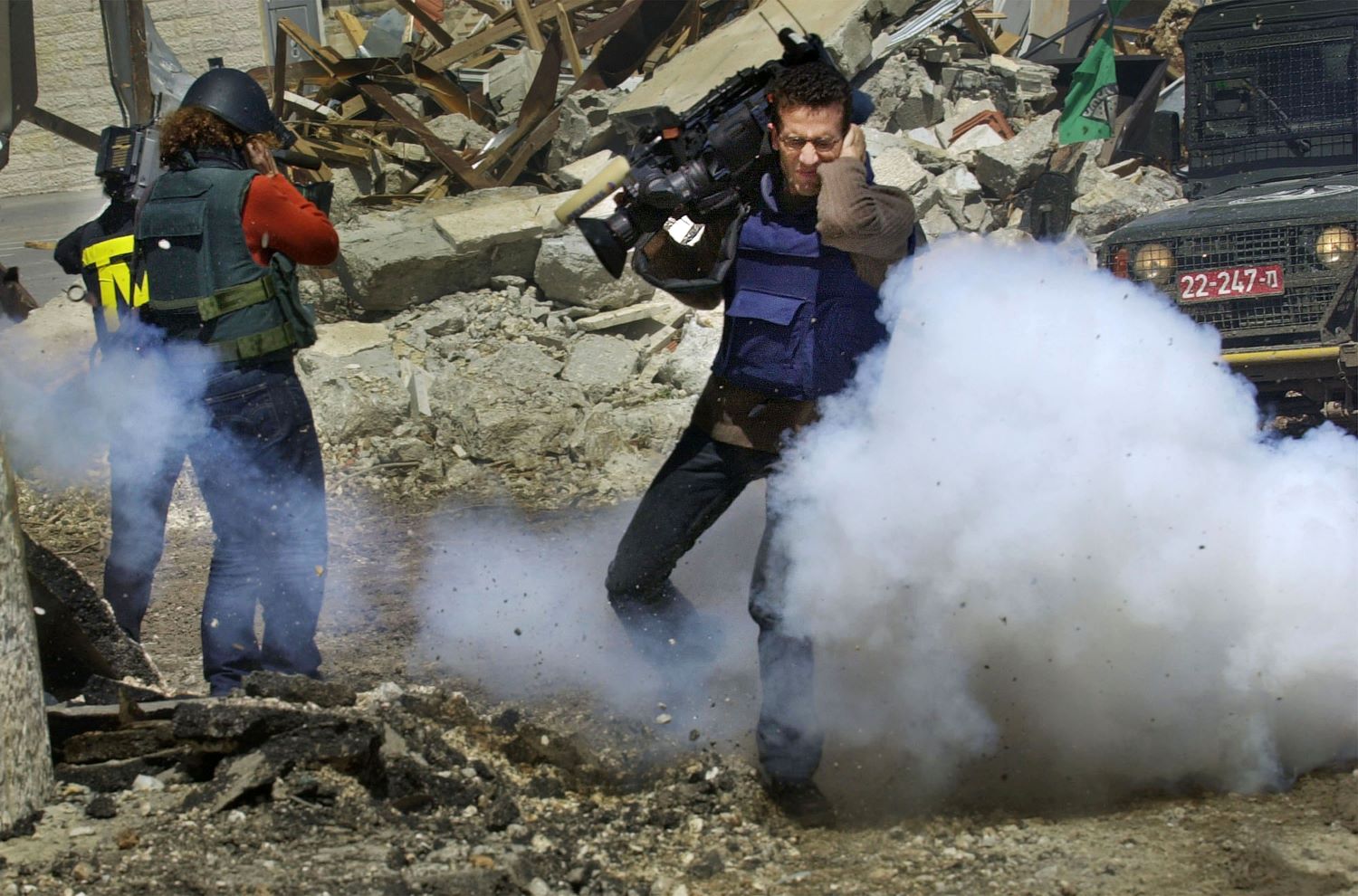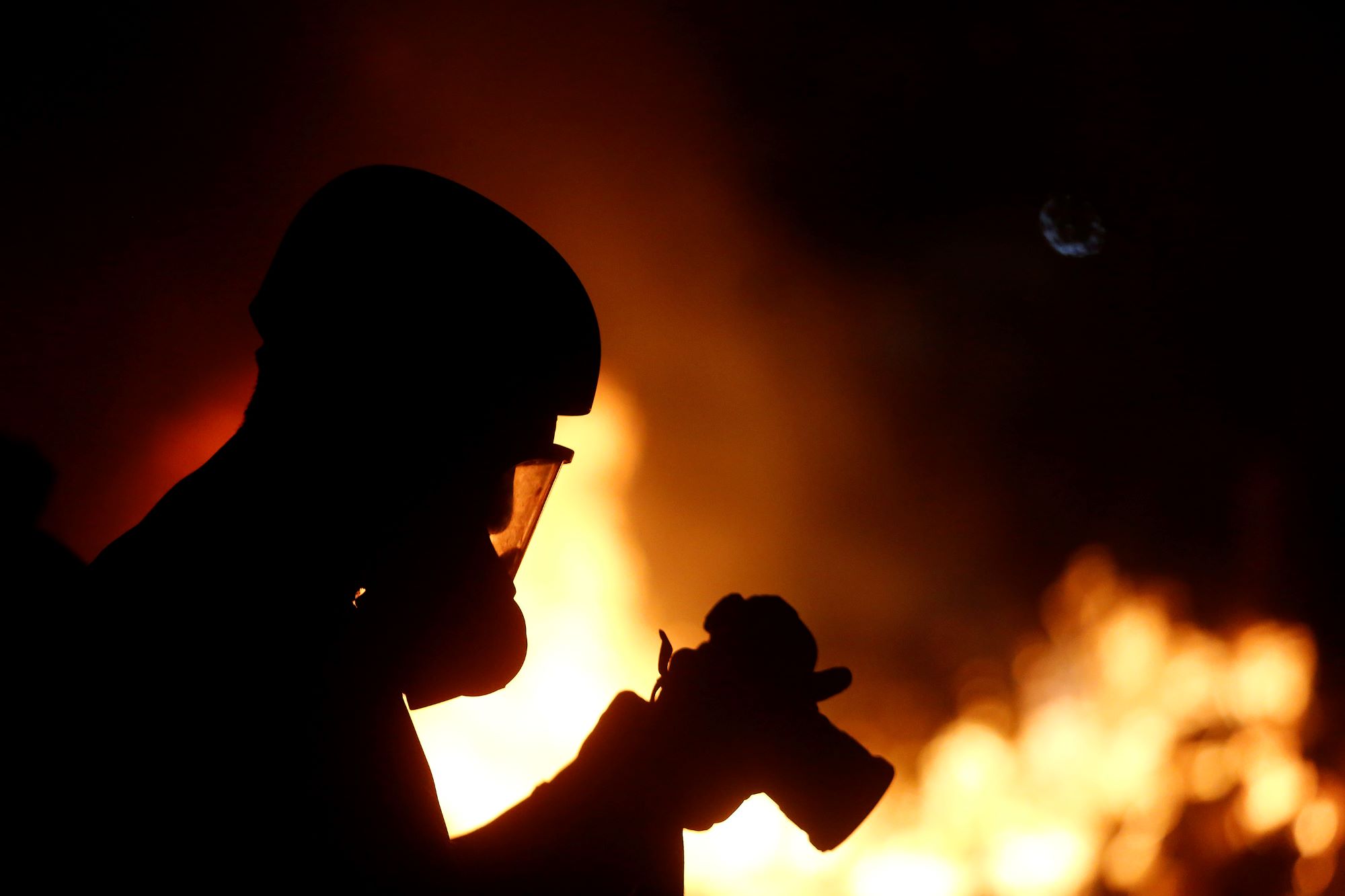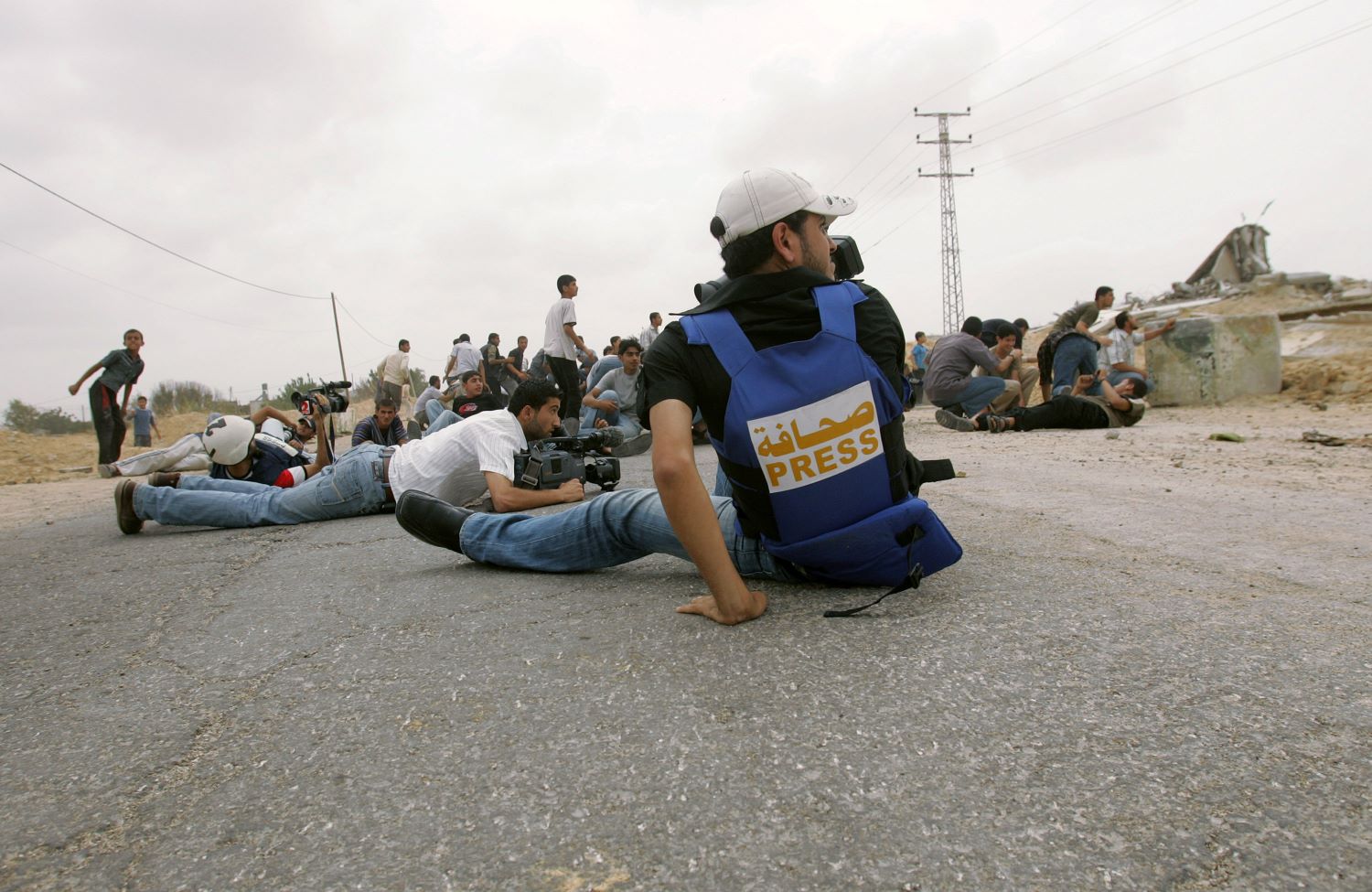Deploying news teams to dangerous places - what media organisations need to know
2022-02-21 11:25

(BEIT LAYEA, GAZA STRIP: Palestinians and a television cameraman take cover as an Israeli tank opens fire during clashes March 7, 2003 in Beit Lahyea in the Gaza Strip. [Abid Katib/Getty Images]
Deploying news teams to dangerous places - what media organisations need to know
Aidan White-Al Jazeera Media Institute
Reporting from the heat of battle or covering the tragedy and desolation of a humanitarian disaster can be perilous, but the risks are less if media professionals are prepared for the task.
All news media have a duty of care to the reporters and other media workers they send into dangerous places. When things go wrong, media have to take responsibility, particularly when people are hurt or killed. They should ensure that they are well-prepared for the challenges of risk reporting by creating internal systems of good governance, safety-conscious editorial management and respect for ethics by journalists working in the field.
It goes without saying that any journalist going on a risky assignment should do their homework. Packing the right equipment, alerting reliable contacts in the field, and being fully briefed on the political and cultural terrain as well as local laws and international humanitarian law are essential.
Journalists should be physically and mentally primed with some first aid knowledge and a session of hostile environment training under their belt. We keep insisting on this, time and again, because unfortunately, many are not.
Very often, journalists are recklessly ill-equipped for dangerous missions and they may take unacceptable risks, endangering their own lives and the people around them. Some work without insurance cover or clear working contracts or commissions from responsible media.
A few of them travel into dangerous hot-spots without any serious understanding of what they are getting themselves into. Only a minority has safety training.
This practice needs to be discouraged, but at a time when newsroom budgets are under pressure some unscrupulous media may cut corners on the security of their staff to save money. Increasingly, journalists have to look out for themselves.

The situation is not made any easier in the face of media competition. The impulse to be the first with exclusive coverage of violence leads to more risk-taking. Even the best media may sometimes turn a blind-eye to behaviour that breaks the rules if it delivers dramatic footage.
Of course, there are no guarantees about safety. Accidents do happen and when bullets fly or crowds are on the rampage anyone can get hurt, but media organisations can minimise the threats to their people.
With this in mind, the following guidelines have been prepared by the Ethical Journalism Network, drawing upon experience and advice from the media industry over the past 30 years and from key organisations such as the International News Safety Institute and the International Federation of Journalists.
These guidelines provide a few suggestions to help media reduce the risks facing their staff. They are not exhaustive, and media should prepare their own purpose-built system, but all safety policies should include:
- Guidance for media managers on the steps they need to take to create working conditions for the safe exercise of journalism
- A checklist for commissioning editors to ensure they are getting the story without sacrificing safety
- Minimum standards for working with fixers and support staff in the field
- Tips for everyone at all levels on ethical behaviour and, in particular, how to deal with propaganda, hate speech and incitement to violence, especially during wartime

Getting started: An internal safety audit
Large media companies have human resources departments to manage their staff, but most media today are small or medium sized operations and all of them are financially stretched.
Very often they employ people on flexible or short-term contracts, but that is no excuse for not ensuring that everyone who is potentially at risk is given the protection they need to work safely.
News media should carry out annual audits of their safety needs that identify the risks their staff face and the need in terms of safety equipment and staff training. This audit should establish baseline standards for their staff in terms of insurance, training and equipment and it is not just for head office – the audit should also examine the capacity and performance of the company’s foreign bureaux.
The audit, which should include a review of numbers of staff (and freelance) at potential risk, should examine the company’s performance and capacity in the following areas:
- Provision of training and security protection
- Provision of health and life insurance to vulnerable staff members
- Other education, training, counselling, prevention, and risk-control actions covering serious diseases, stress related conditions, and physical attacks
- Special measures to deal with support for women staff
- Health and safety topics covered in formal agreements with trade unions and journalism syndicates
- Engagement with safety activities at national and international level including International News Safety Institute

Media management
Media managers may not travel into the field, but they should develop internal systems of governance that promote awareness of the potential risks staff face and ways of dealing with a security crisis when it arises.
In particular, they will ensure that the media organisation maintains the professional integrity of its editorial work by not allowing any form of political bias in reporting or the perception of any undue political influence from any side in a conflict.
Good managers will develop a health and safety regime that protects everyone employed by the company and that recognises that journalists and people who work with them face particular problems that require special attention. They should ensure that they and their commissioning editors, newsroom executives and journalists working in the field are fully briefed on policy and law that affects their safety, including the United Nations Plan of Action on the Safety of Journalists and elements of International Humanitarian Law (IHL) that provide protection for journalists.
Managers must also ensure that specific attention is paid to gender-related issues when it comes to safety. Recent research shows that special consideration of the challenges facing women reporting on risky assignments is urgently required. According to the International Women’s Media Foundation, the threat of harassment, bullying and intimidation of female journalists should be part of a company’s safety strategy.
This and other questions should form part of an internal safety information programme that includes detailed guidelines and advice for all staff. This information should draw upon the experience of reporters and editors who have worked in the field. Some companies have created internal handbooks with useful information for their staff.
Such guidelines should emphasise:
- That the company’s field operations (branch offices and foreign bureaux) are fit for purpose with the capacity to implement emergency measures in the event of injury, death or other life-threatening crisis.
- That all staff or freelance journalists or fixers and assistants in the field have received appropriate safety training and briefings on company policy on safety before they are deployed. It may be useful to prepare a targeted “Fixer’s Handbook” which outlines company policy and guidance for employees on short-term contracts.
- That staff who are most likely to face high risks (those travelling in conflict areas, for instance) are given medical checks and offered counselling to ensure they are fully fit for the tasks they face.
- That all staff and support workers are in possession of appropriate equipment for their assignment including communications support (telephones and where necessary satellite links) as well as flag jackets, helmets and essential documents covering their identity, role and responsibilities.
- That life insurance and health cover is a mandatory provision for all staff and freelancers and must be extended also to support staff in the field.
- That staff returning from dangerous assignments or events where there has been trauma and distress are systematically and compulsorily subject to a process of debriefing which allows, if necessary, for personal and confidential counselling.

Commissioning editors and newsroom leaders
Editors and newsroom executives are primarily responsible for implementing company safety policy. They must ensure that in day-to-day work they balance carefully editorial and professional objectives with the need to protect staff. They should be trained to identify stress and trauma, which may threaten the well-being of staff under their jurisdiction.
In addition, they must ensure:
- That all employees and support staff are informed that taking unjustified risks in pursuit of a story or a picture is unacceptable. Safety must always come before competitive advantage.
- That staff or freelancers employed or commissioned to report from dangerous areas should be made fully aware of the potential risks and must be able, without fear of disadvantage, to refuse any assignment on the grounds of potential risk.
- That management are responsible for carefully monitoring dangerous assignments and that all staff should report regularly to their superiors on the security situation.
- That while respecting the need to be guided by journalists working on the ground who are best able to judge reporting conditions, editorial management should be ready, where appropriate, to instruct their staff and freelancers to withdraw to secure positions if safety is compromised.
- That the company only commissions work from people they know or who they have verified in terms of professional capacity for any tasks that involve undertaking potentially dangerous assignments.

Ethical reporting
Journalists who do their job ethically and responsibly are more likely to be safer than those who deliberately bend ethical rules to exaggerate or sensationalise a story.
It is particularly important to ensure that reporting does not cross a line into propaganda and become a vehicle for intolerance or intense hatred that may increase levels of violence.
Journalists will do well to work strictly within the ethical framework of journalism – sticking to the facts and avoiding rumour and speculation; showing humanity and respect for the victims of violence; avoiding bias in favour of one side or another; keeping clear of all forms of hate speech designed to incite more violence; and correcting errors when they are revealed.
Commissioning editors should ensure:
- That all material submitted from conflict zones or from traumatic events should be fully verified and corroborated prior to publication and should not be sensationalised in any way that might put reporters or field staff at risk.
- That the pattern of coverage does not give rise to a perception of editorial bias, politically or strategically, particularly if that could lead to the targeting of the company’s reporting staff on the ground.
Journalists and editors can reduce the impact of intolerance and hate speech by challenging outrageous statements of politicians; putting all factual claims to the test of verification; avoiding use of explicit images of violence and brutality; and ensuring the coverage is inclusive of all legitimate voices in a conflict.
One useful tool developed by the Ethical Journalism Network is the 5-Point Test for hate speech, which journalists and editors can use to help them decide how to treat controversial statements and incendiary speech.
Adopting these guidelines and ethical standards will help media develop a culture of safety in their management and newsroom operations, but it may also ensure that media and ethical journalism play a positive role in helping warring communities to step back from violence.
Journalism is not about making peace; that is the job of others, particularly politicians and community leaders, but good journalism will create understanding of the roots of conflict and can provide scope for dialogues that may lead to positive change.
An earlier version of this article first appeared in the Al Jazeera Media Institute publication, Journalism in Times of War









